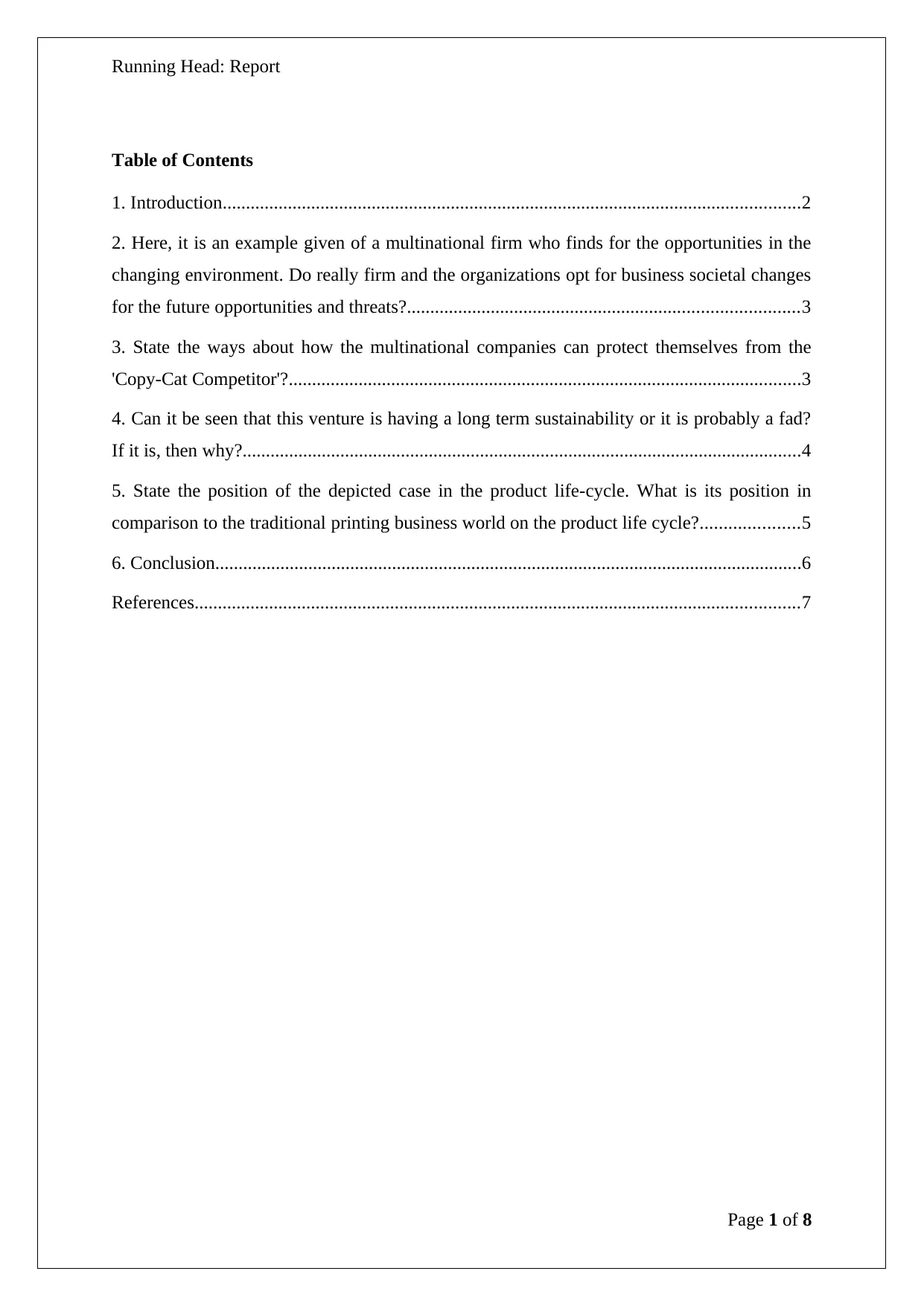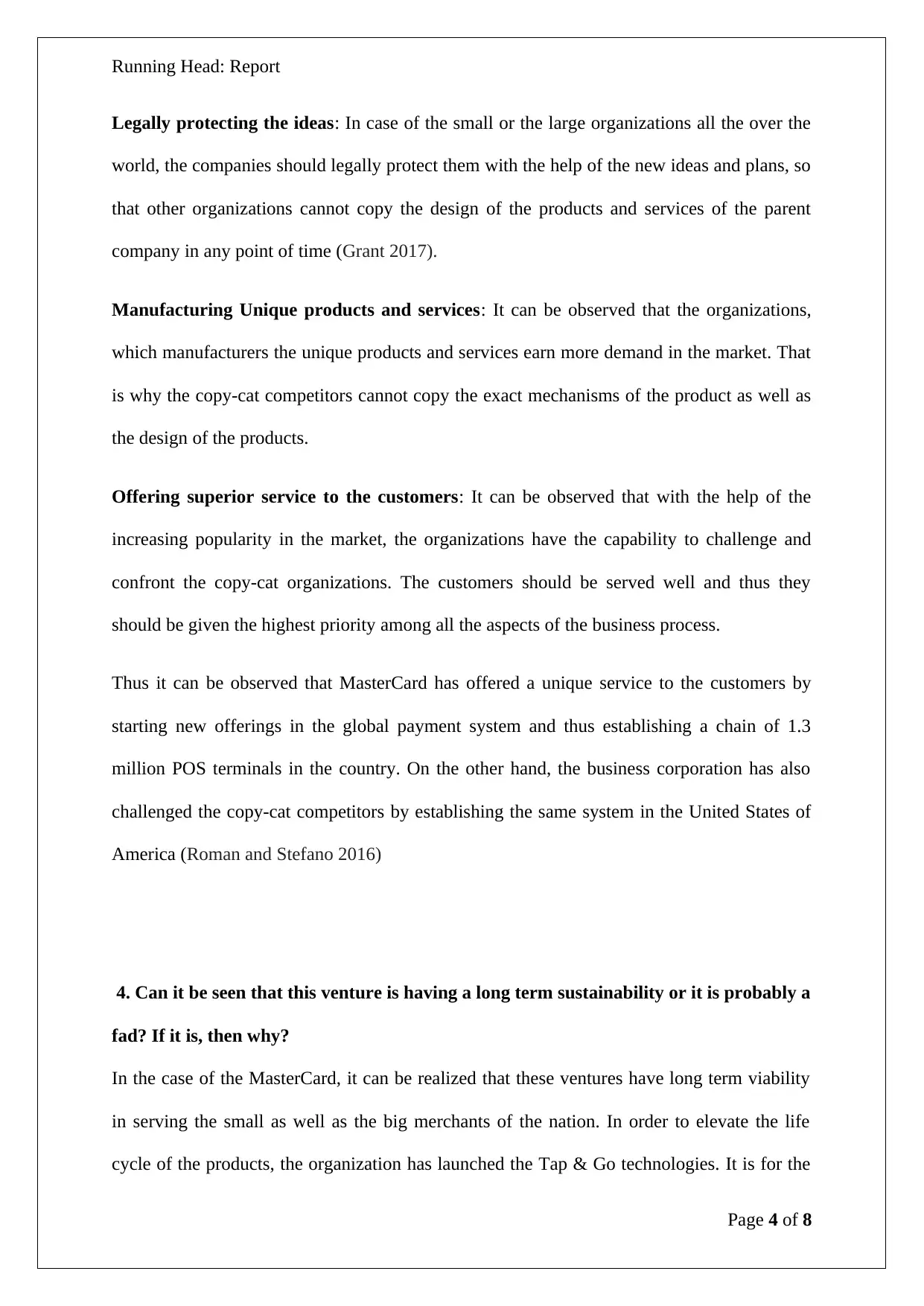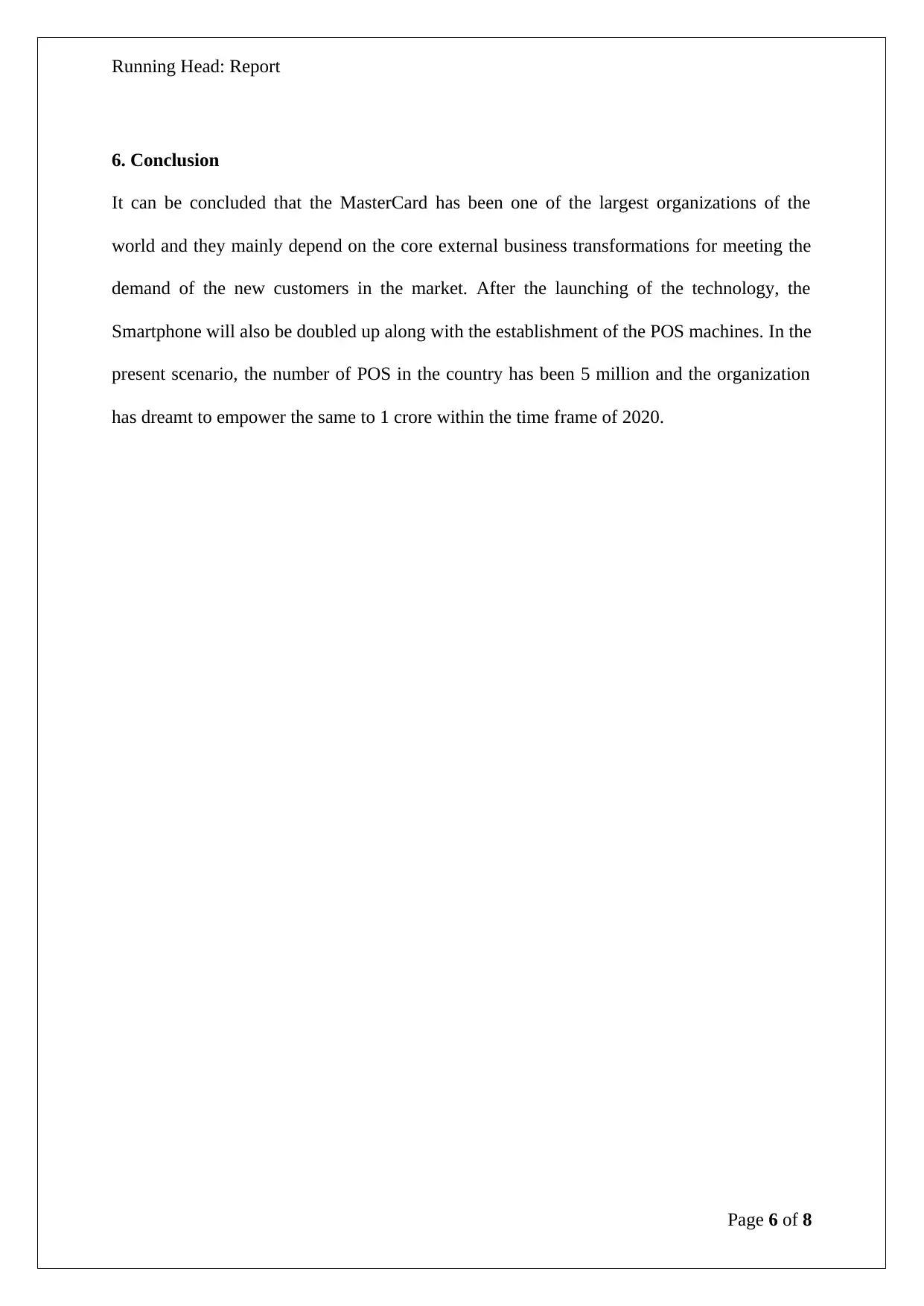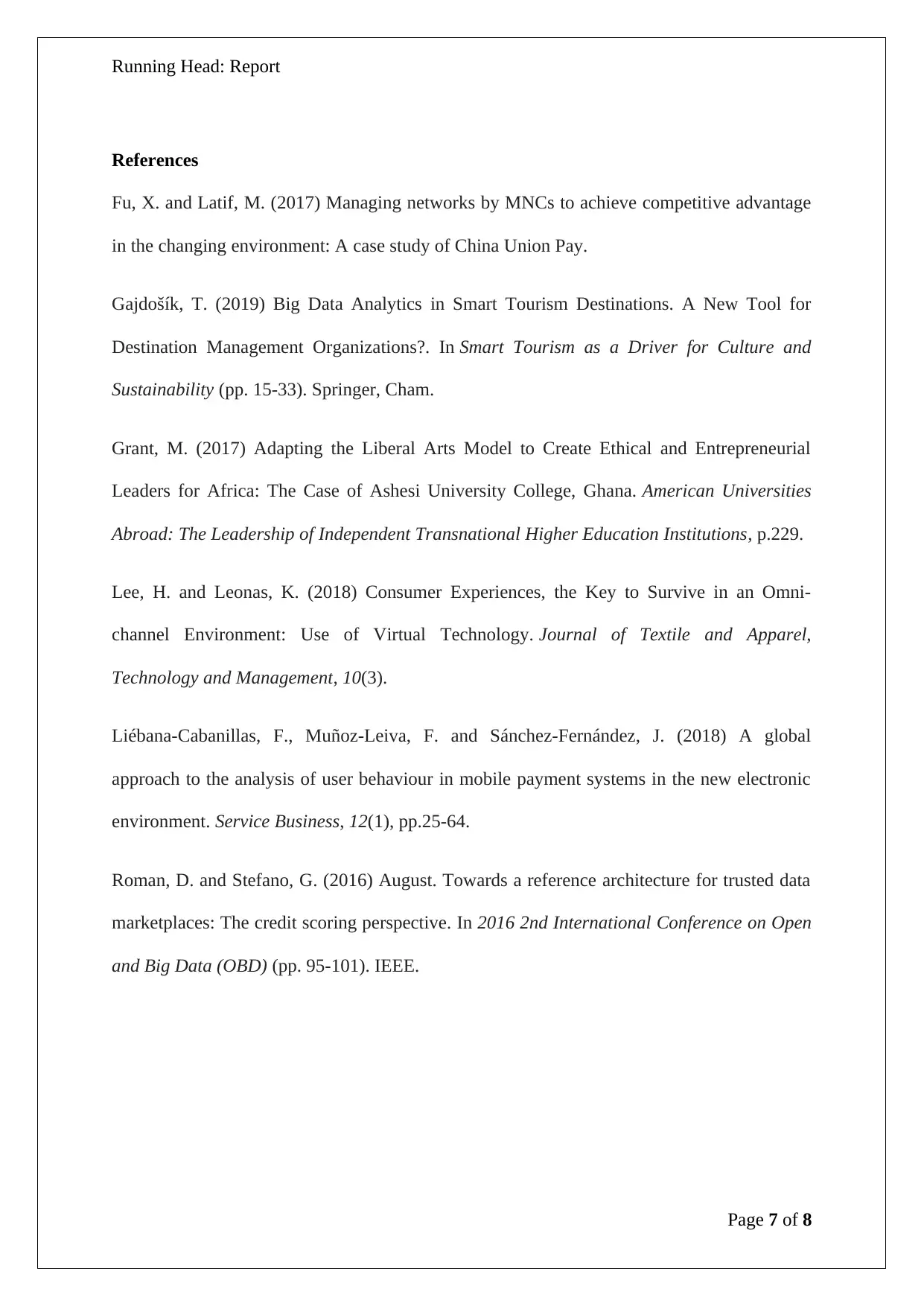Case Study Analysis: MasterCard's Contactless Payment Strategy
VerifiedAdded on 2023/03/21
|8
|1595
|97
Case Study
AI Summary
This case study examines MasterCard's strategic move to introduce contactless payment technology, particularly targeting the SME sector. It analyzes how MasterCard adapts to the changing business environment, identifying opportunities and threats. The study discusses how MasterCard protects itself from competitors, assesses the long-term sustainability of this venture, and determines its position in the product life cycle compared to traditional printing businesses. The case highlights the importance of adapting to market demands, offering superior customer service, and leveraging new technologies like NFC-enabled smartphones and POS machines. It also explores the implications of this technology, especially in markets like India, where small transactions are prevalent, and the potential for significant growth in the SME sector through cost-effective and efficient payment solutions. The conclusion emphasizes MasterCard's reliance on external business transformations and its commitment to empowering businesses with advanced payment solutions.

Case Study 2: Adapting to the New Environment
Paraphrase This Document
Need a fresh take? Get an instant paraphrase of this document with our AI Paraphraser

Running Head: Report
Table of Contents
1. Introduction............................................................................................................................2
2. Here, it is an example given of a multinational firm who finds for the opportunities in the
changing environment. Do really firm and the organizations opt for business societal changes
for the future opportunities and threats?....................................................................................3
3. State the ways about how the multinational companies can protect themselves from the
'Copy-Cat Competitor'?..............................................................................................................3
4. Can it be seen that this venture is having a long term sustainability or it is probably a fad?
If it is, then why?........................................................................................................................4
5. State the position of the depicted case in the product life-cycle. What is its position in
comparison to the traditional printing business world on the product life cycle?.....................5
6. Conclusion..............................................................................................................................6
References..................................................................................................................................7
Page 1 of 8
Table of Contents
1. Introduction............................................................................................................................2
2. Here, it is an example given of a multinational firm who finds for the opportunities in the
changing environment. Do really firm and the organizations opt for business societal changes
for the future opportunities and threats?....................................................................................3
3. State the ways about how the multinational companies can protect themselves from the
'Copy-Cat Competitor'?..............................................................................................................3
4. Can it be seen that this venture is having a long term sustainability or it is probably a fad?
If it is, then why?........................................................................................................................4
5. State the position of the depicted case in the product life-cycle. What is its position in
comparison to the traditional printing business world on the product life cycle?.....................5
6. Conclusion..............................................................................................................................6
References..................................................................................................................................7
Page 1 of 8

Running Head: Report
1. Introduction
The main and the primary motive of the study is about the core changing environment and the
hidden opportunities within the transforming business and societal environment. Thus, it has
been discussed about most of the organizations whether they depend on the changing
environment for their core opportunity and the threat or not. The methods about the firm will
protect themselves from the replicated competitors have also been demonstrated along with
the long term liabilities of the business ventures in the current external business scenarios.
The position of the venture in the product life cycle along with the position on the traditional
printing business have also been elaborated in the study (Fu and Latif 2017).
Page 2 of 8
1. Introduction
The main and the primary motive of the study is about the core changing environment and the
hidden opportunities within the transforming business and societal environment. Thus, it has
been discussed about most of the organizations whether they depend on the changing
environment for their core opportunity and the threat or not. The methods about the firm will
protect themselves from the replicated competitors have also been demonstrated along with
the long term liabilities of the business ventures in the current external business scenarios.
The position of the venture in the product life cycle along with the position on the traditional
printing business have also been elaborated in the study (Fu and Latif 2017).
Page 2 of 8
⊘ This is a preview!⊘
Do you want full access?
Subscribe today to unlock all pages.

Trusted by 1+ million students worldwide

Running Head: Report
2. Here, it is an example given of a multinational firm who finds for the opportunities in
the changing environment. Do really firm and the organizations opt for business societal
changes for the future opportunities and threats?
It is certain that most of the organization in the external business scenario are core dependent
on the transformations in the business environment and with the help of the same change in
the business, they will get the optimum opportunity and threat at the time of the business
procedure. In the case of the MasterCard, it has been much observed and realized that they
have launched new payment technologies for the small business retailers in the country. The
merchants will operate the system with the help of their Smartphone and the POS machine.
On the other hand, it can be observed that the MasterCard has also launched the same in the
market of the United States of America because in that market they have more demand of the
POS machines and of the global payment solutions (Liébana-Cabanillas et al. 2018).
Thus, it can be observed from the above scenario that all the organizations in the world find a
deeper opportunity in the changing business environment for their optimum growth within a
limited time period. If the firm will not change with the changing environment and the
demand of the customers, then the organization or the industry are known as the traditional or
the sick industries, where productivity is much lower (Gajdošík 2019).
3. State the ways about how the multinational companies can protect themselves from
the 'Copy-Cat Competitor'?
There are five simple ways of protecting the organization from the 'copy-cat competitors'.
Page 3 of 8
2. Here, it is an example given of a multinational firm who finds for the opportunities in
the changing environment. Do really firm and the organizations opt for business societal
changes for the future opportunities and threats?
It is certain that most of the organization in the external business scenario are core dependent
on the transformations in the business environment and with the help of the same change in
the business, they will get the optimum opportunity and threat at the time of the business
procedure. In the case of the MasterCard, it has been much observed and realized that they
have launched new payment technologies for the small business retailers in the country. The
merchants will operate the system with the help of their Smartphone and the POS machine.
On the other hand, it can be observed that the MasterCard has also launched the same in the
market of the United States of America because in that market they have more demand of the
POS machines and of the global payment solutions (Liébana-Cabanillas et al. 2018).
Thus, it can be observed from the above scenario that all the organizations in the world find a
deeper opportunity in the changing business environment for their optimum growth within a
limited time period. If the firm will not change with the changing environment and the
demand of the customers, then the organization or the industry are known as the traditional or
the sick industries, where productivity is much lower (Gajdošík 2019).
3. State the ways about how the multinational companies can protect themselves from
the 'Copy-Cat Competitor'?
There are five simple ways of protecting the organization from the 'copy-cat competitors'.
Page 3 of 8
Paraphrase This Document
Need a fresh take? Get an instant paraphrase of this document with our AI Paraphraser

Running Head: Report
Legally protecting the ideas: In case of the small or the large organizations all the over the
world, the companies should legally protect them with the help of the new ideas and plans, so
that other organizations cannot copy the design of the products and services of the parent
company in any point of time (Grant 2017).
Manufacturing Unique products and services: It can be observed that the organizations,
which manufacturers the unique products and services earn more demand in the market. That
is why the copy-cat competitors cannot copy the exact mechanisms of the product as well as
the design of the products.
Offering superior service to the customers: It can be observed that with the help of the
increasing popularity in the market, the organizations have the capability to challenge and
confront the copy-cat organizations. The customers should be served well and thus they
should be given the highest priority among all the aspects of the business process.
Thus it can be observed that MasterCard has offered a unique service to the customers by
starting new offerings in the global payment system and thus establishing a chain of 1.3
million POS terminals in the country. On the other hand, the business corporation has also
challenged the copy-cat competitors by establishing the same system in the United States of
America (Roman and Stefano 2016)
4. Can it be seen that this venture is having a long term sustainability or it is probably a
fad? If it is, then why?
In the case of the MasterCard, it can be realized that these ventures have long term viability
in serving the small as well as the big merchants of the nation. In order to elevate the life
cycle of the products, the organization has launched the Tap & Go technologies. It is for the
Page 4 of 8
Legally protecting the ideas: In case of the small or the large organizations all the over the
world, the companies should legally protect them with the help of the new ideas and plans, so
that other organizations cannot copy the design of the products and services of the parent
company in any point of time (Grant 2017).
Manufacturing Unique products and services: It can be observed that the organizations,
which manufacturers the unique products and services earn more demand in the market. That
is why the copy-cat competitors cannot copy the exact mechanisms of the product as well as
the design of the products.
Offering superior service to the customers: It can be observed that with the help of the
increasing popularity in the market, the organizations have the capability to challenge and
confront the copy-cat organizations. The customers should be served well and thus they
should be given the highest priority among all the aspects of the business process.
Thus it can be observed that MasterCard has offered a unique service to the customers by
starting new offerings in the global payment system and thus establishing a chain of 1.3
million POS terminals in the country. On the other hand, the business corporation has also
challenged the copy-cat competitors by establishing the same system in the United States of
America (Roman and Stefano 2016)
4. Can it be seen that this venture is having a long term sustainability or it is probably a
fad? If it is, then why?
In the case of the MasterCard, it can be realized that these ventures have long term viability
in serving the small as well as the big merchants of the nation. In order to elevate the life
cycle of the products, the organization has launched the Tap & Go technologies. It is for the
Page 4 of 8

Running Head: Report
core benefit for the small merchants and the businessmen, who will be able to accept the core
contactless payments by using the NFC- enabled Smart devices or the phones.
On the other hand, in case of the long term viability of the organizations, the manufactured or
the developed technology has been one of the most important phenomena for the small
investors and the customers. This technology or the machinery is also much cost effective
and it also contains some of the quicker check-out features and the options for handling the
Contactless POS machines. Moreover, the MasterCard has only manoeuvred over the
technology for the long term sustenance and viability (Lee and Leonas 2018).
5. State the position of the depicted case in the product life-cycle. What is its position in
comparison to the traditional printing business world on the product life cycle?
In this case, it can be understood that in the core stage of the product life cycle, the product or
the services is in the last stage. The product has been manufactured and it will start
distributing in the various sectors of the world. It is the last stage of the product life cycle,
where the product has been mechanized and there is a possibility of getting released in the
market. However, in comparison to the traditional printing business in the product life cycle,
it is in a much-underdeveloped stage and should not get compared with the new venture that
will be launched by the MasterCard (Gajdošík 2019).
Page 5 of 8
core benefit for the small merchants and the businessmen, who will be able to accept the core
contactless payments by using the NFC- enabled Smart devices or the phones.
On the other hand, in case of the long term viability of the organizations, the manufactured or
the developed technology has been one of the most important phenomena for the small
investors and the customers. This technology or the machinery is also much cost effective
and it also contains some of the quicker check-out features and the options for handling the
Contactless POS machines. Moreover, the MasterCard has only manoeuvred over the
technology for the long term sustenance and viability (Lee and Leonas 2018).
5. State the position of the depicted case in the product life-cycle. What is its position in
comparison to the traditional printing business world on the product life cycle?
In this case, it can be understood that in the core stage of the product life cycle, the product or
the services is in the last stage. The product has been manufactured and it will start
distributing in the various sectors of the world. It is the last stage of the product life cycle,
where the product has been mechanized and there is a possibility of getting released in the
market. However, in comparison to the traditional printing business in the product life cycle,
it is in a much-underdeveloped stage and should not get compared with the new venture that
will be launched by the MasterCard (Gajdošík 2019).
Page 5 of 8
⊘ This is a preview!⊘
Do you want full access?
Subscribe today to unlock all pages.

Trusted by 1+ million students worldwide

Running Head: Report
6. Conclusion
It can be concluded that the MasterCard has been one of the largest organizations of the
world and they mainly depend on the core external business transformations for meeting the
demand of the new customers in the market. After the launching of the technology, the
Smartphone will also be doubled up along with the establishment of the POS machines. In the
present scenario, the number of POS in the country has been 5 million and the organization
has dreamt to empower the same to 1 crore within the time frame of 2020.
Page 6 of 8
6. Conclusion
It can be concluded that the MasterCard has been one of the largest organizations of the
world and they mainly depend on the core external business transformations for meeting the
demand of the new customers in the market. After the launching of the technology, the
Smartphone will also be doubled up along with the establishment of the POS machines. In the
present scenario, the number of POS in the country has been 5 million and the organization
has dreamt to empower the same to 1 crore within the time frame of 2020.
Page 6 of 8
Paraphrase This Document
Need a fresh take? Get an instant paraphrase of this document with our AI Paraphraser

Running Head: Report
References
Fu, X. and Latif, M. (2017) Managing networks by MNCs to achieve competitive advantage
in the changing environment: A case study of China Union Pay.
Gajdošík, T. (2019) Big Data Analytics in Smart Tourism Destinations. A New Tool for
Destination Management Organizations?. In Smart Tourism as a Driver for Culture and
Sustainability (pp. 15-33). Springer, Cham.
Grant, M. (2017) Adapting the Liberal Arts Model to Create Ethical and Entrepreneurial
Leaders for Africa: The Case of Ashesi University College, Ghana. American Universities
Abroad: The Leadership of Independent Transnational Higher Education Institutions, p.229.
Lee, H. and Leonas, K. (2018) Consumer Experiences, the Key to Survive in an Omni-
channel Environment: Use of Virtual Technology. Journal of Textile and Apparel,
Technology and Management, 10(3).
Liébana-Cabanillas, F., Muñoz-Leiva, F. and Sánchez-Fernández, J. (2018) A global
approach to the analysis of user behaviour in mobile payment systems in the new electronic
environment. Service Business, 12(1), pp.25-64.
Roman, D. and Stefano, G. (2016) August. Towards a reference architecture for trusted data
marketplaces: The credit scoring perspective. In 2016 2nd International Conference on Open
and Big Data (OBD) (pp. 95-101). IEEE.
Page 7 of 8
References
Fu, X. and Latif, M. (2017) Managing networks by MNCs to achieve competitive advantage
in the changing environment: A case study of China Union Pay.
Gajdošík, T. (2019) Big Data Analytics in Smart Tourism Destinations. A New Tool for
Destination Management Organizations?. In Smart Tourism as a Driver for Culture and
Sustainability (pp. 15-33). Springer, Cham.
Grant, M. (2017) Adapting the Liberal Arts Model to Create Ethical and Entrepreneurial
Leaders for Africa: The Case of Ashesi University College, Ghana. American Universities
Abroad: The Leadership of Independent Transnational Higher Education Institutions, p.229.
Lee, H. and Leonas, K. (2018) Consumer Experiences, the Key to Survive in an Omni-
channel Environment: Use of Virtual Technology. Journal of Textile and Apparel,
Technology and Management, 10(3).
Liébana-Cabanillas, F., Muñoz-Leiva, F. and Sánchez-Fernández, J. (2018) A global
approach to the analysis of user behaviour in mobile payment systems in the new electronic
environment. Service Business, 12(1), pp.25-64.
Roman, D. and Stefano, G. (2016) August. Towards a reference architecture for trusted data
marketplaces: The credit scoring perspective. In 2016 2nd International Conference on Open
and Big Data (OBD) (pp. 95-101). IEEE.
Page 7 of 8
1 out of 8
Your All-in-One AI-Powered Toolkit for Academic Success.
+13062052269
info@desklib.com
Available 24*7 on WhatsApp / Email
![[object Object]](/_next/static/media/star-bottom.7253800d.svg)
Unlock your academic potential
Copyright © 2020–2025 A2Z Services. All Rights Reserved. Developed and managed by ZUCOL.

